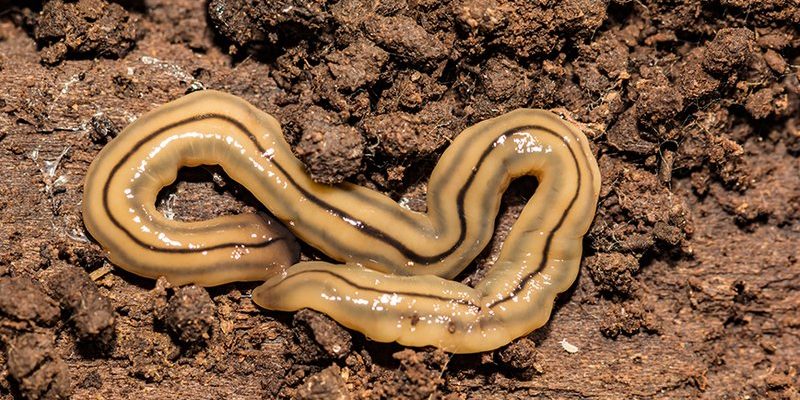
Let’s explore the world of hammerhead worms, their role in the ecosystem, and whether they’re a friend or foe to your garden. Imagine we’re sitting over coffee, and I’m laying out the fascinating details about these oddball worms and their impact on the soil you care about.
What Are Hammerhead Worms?
Hammerhead worms, scientifically known as Bipalium, are a type of flatworm. You can easily identify them by their distinct hammer-like heads that give them their name. Most of these worms are an eye-catching mix of brown and yellow, which helps them blend in with the soil.
These worms are primarily found in tropical and subtropical regions, but they’ve started popping up in other areas as well, often hitching a ride in potted plants or soil. They thrive in moist environments, which is why you might find them in your garden after a rain.
Interestingly, hammerhead worms are carnivorous and feed mainly on earthworms and other small soil-dwelling creatures. This behavior raises some important questions about their impact on soil health, which we’ll dig into shortly. But first, let’s take a closer look at how they interact with their environment.
Hammerhead Worms and Soil Ecosystems
Let’s break it down: soil is a bustling city of microbes, insects, and plants, all working together. Hammerhead worms occupy a specific niche in this environment. As predators, they help control earthworm populations, which can be beneficial in some cases.
However, here’s the thing: excessive predation can lead to a lack of earthworms, which are crucial for creating nutrient-rich soil. Earthworms aerate the soil, break down organic matter, and help retain moisture. Without them, the soil can become compacted and less fruitful.
So, while hammerhead worms might help keep earthworm numbers in check, they can also tip the balance too far and harm the soil’s health. If your garden depends on healthy soil, this is a significant concern.
Are Hammerhead Worms Harmful to Gardens?
You might be wondering if hammerhead worms pose a threat to your garden. The short answer? It depends. If you have a healthy population of earthworms and other beneficial organisms, a few hammerhead worms probably won’t cause much harm.
But if you notice a decline in your earthworm population, it might be time to take action. Some gardeners report that the presence of hammerhead worms correlates with a decrease in healthy soil, leading to poorer plant growth and yields.
Interestingly, hammerhead worms are also known to be toxic. They possess a powerful neurotoxin that can deter predators. While this is more relevant in their natural habitats, it’s a reminder that these worms are not harmless. If you’re dealing with a severe infestation, it’s vital to consider the health of your plants and soil.
How to Identify Hammerhead Worms
Recognizing hammerhead worms is the first step in managing their populations. Here are some distinctive features to look out for:
- Head Shape: The most noticeable feature is their hammer-shaped head.
- Coloration: They often appear brown or gray with lighter stripes.
- Body Shape: Their bodies are flat and can range from a few inches to over a foot long.
- Movement: Unlike earthworms, hammerhead worms move in a smooth, gliding manner.
If you find these in your garden, it’s essential to keep an eye on their numbers. Just because they’re fascinating doesn’t mean they should take over!
Managing Hammerhead Worm Populations
If you decide that the hammerhead worms in your garden are a problem, here are some methods to manage their populations effectively:
- Hand Removal: If you see them, you can remove them manually. Use gloves, as they can secrete a slime that may irritate your skin.
- Reduce Moisture: Since these worms thrive in wet conditions, reducing moisture in your garden can help deter them.
- Encourage Earthworms: By creating a healthy environment for earthworms, you can help balance the ecosystem. Add organic matter like compost or mulch to enhance their population.
- Chemical Controls: If necessary, certain pesticides can target hammerhead worms. However, always check with local guidelines to choose a safe option for your garden and surrounding wildlife.
Let’s remember that balance is key. You want your garden to flourish and your soil to stay healthy.
Hammerhead worms are intriguing creatures with a complex role in soil health. While they can act as predators, keeping some populations in check, their presence can also hinder the earthworm populations that support healthy soil.
As gardeners, it’s essential to maintain that balance. If you spot these worms, consider their numbers and the state of your garden. A little vigilance can go a long way in ensuring your soil remains vibrant and productive.
So, keep your eyes peeled! Nature is full of surprises, and understanding these surprises—like the quirky hammerhead worm—can help you cultivate a healthier garden. After all, thriving soil leads to thriving plants. Happy gardening!

